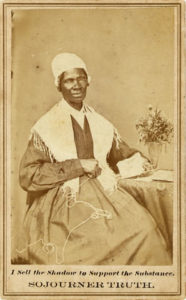By Morgan Clark
 Sojourner Truth is known for her work as an abolitionist and her work in the Civil War that caught the attention of President Abraham Lincoln. Born Isabella Baumfree in 1797, she was born into slavery in New York and was sold to her first slave master at the age of 9. He was known to beat and abuse his slaves regularly. At the age of 13, she was sold again to her second slave master. Around 1815, Isabella was forced to marry a slave and bore five children, after being forced apart from the man she loved.
Sojourner Truth is known for her work as an abolitionist and her work in the Civil War that caught the attention of President Abraham Lincoln. Born Isabella Baumfree in 1797, she was born into slavery in New York and was sold to her first slave master at the age of 9. He was known to beat and abuse his slaves regularly. At the age of 13, she was sold again to her second slave master. Around 1815, Isabella was forced to marry a slave and bore five children, after being forced apart from the man she loved.
In 1827 she ran away to freedom, after her master did not honor his promise to free her and the other slaves. She ended up in New Paltz, New York, with her newborn daughter. There, she was taken in by the Wagenens, who eventually paid for her freedom for $20. Isabella then sued her previous slave master for illegally selling her son, Peter. She was the first black woman to sue a white man and win. In 1829, she moved her family to New York City, where she became a Christian and became heavily involved in the Church. She worked closely with two preachers. In 1843 she renamed herself Sojourner Truth because she believed it was her religious obligation to go out and speak the truth. The year after she joined a Massachusetts abolitionist group, where she metFredrick Douglas who had a great influence on her career as an abolitionist.
In 1851, at the Ohio Women’s Right Convention Sojourner Truth gave her famous speech “Ain’t I a Woman?” which addressed the intersection of being a woman and black in that time period. During the convention, she met women’s activists Susan B. Anthony and Elizabeth Lady Stanton.
During the Civil War, Sojourner Truth was an advocate for young men to join the Union. She was able to organize supplies for the young men. Because of her work, she was invited to the White House and recruited to be involved with the Freedmen’s Bureau. She was able to find jobs for freed slaves. During this time, she tried to lobby against segregation and fought to give land to freed slaves. Sojourner Truth was a woman ahead of her time, speaking of intersectionality before it was a term and knowing that segregation was wrong. She died at her home on November 26, 1883. Her tombstone stating, “Is God Dead?” refers to a question she asked her colleague Fredrick Douglas to remind him to stay faithful.